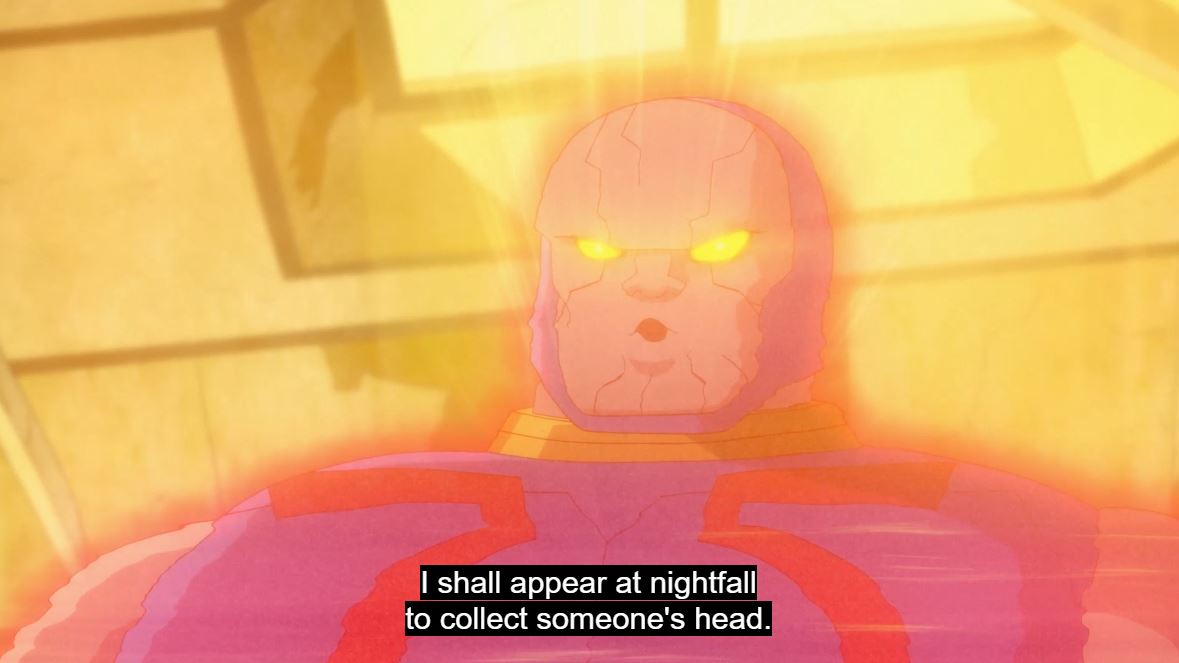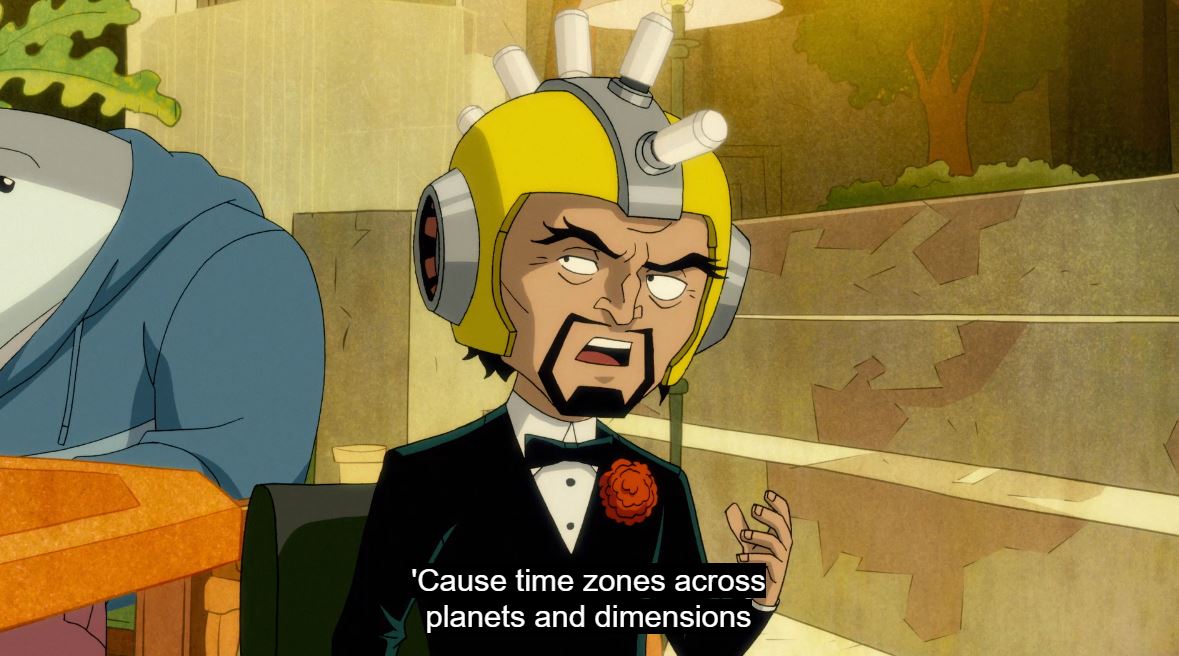In Season 2, Episode 12 of DC Universe’s Harley Quinn animated series, Doctor Psycho was on to a bigger question when he basically tried to ask Darkseid what time he was referring to, his time in Gotham City or that of Apokolips, Darkseid’s homeworld.
To set things up, Doctor Psycho has promised Darkseid that he will bring him the head of Harley Quinn (Harls betrayed Darkseid in the previous episode). In return for killing Harley, Darkseid will allow Psycho to use his Parademons to conqueror earth, which Psycho will then be allowed to rule. The delays just…annoy Darkseid. He’s big on revenge when things don’t go his way.

(c) Warner Bros.

(c) Warner Bros.

(c) Warner Bros.

(c) Warner Bros.

(c) Warner Bros.
The screens tell the story – Psycho promises him Harley’s head, which Darkseid says he’ll return at nightfall to collect. As Darkseid is signing off, Psycho realizes he has no idea which “nightfall” Darkseid is talking about – his or Darkseid’s. As Psycho says – “‘Cause time zones across planets and dimensions are like wah, wah, wah, wah, wah…okay.”
The “wahs” don’t play that well in text form. But short story short, Darkseid had “hung up” before answering Psycho’s question.
The question was played for a joke about time zones, but hinted at the larger idea – there is no constant “time” in the universe. This has a few bigger parts…
What’s in a Day? Would 24 Hours Smell as Sweet?
First, think about the planets in our solar system. They all have their own period of rotation about their axes, and none match what we think of our “earth day” of 24 hours, exactly. On top of that, each travels around the sun at its own rate, again, none matching earth’s period of 365 days, 5 hours, and 48 minutes and 46 seconds.
Each planet, no matter if we’re talking about those in our solar system or exoplanets we’ve only just discovered, have their own lengths for sidereal and solar days. A sidereal day is the amount of time it takes a planet to rotate on its axis so that the “fixed” stars are in the exact same position in the sky they were on the previous day. On earth, our sidereal day is 23 hours, 56 minutes, and 4.1 seconds.
A synodic, or solar day is classified as the time it takes for the earth to move around its axis with respect to the sun, so the sun appears in the same place in the sky on successive days. A solar day on earth is 24 hours. Solar and sidereal differ due to the earth’s orbit around the sun. As a result of that, the earth must rotate more than 360 degrees for a solar day. Obviously, we use the solar day for our measurements of time, which is why, in part, stars and constellations will move through the sky over a period of successive nights.
Taking these differences between sidereal and solar days, let’s take Venus for example. Venus spins slow – really slow. Slowest in the solar system, and it does it clockwise, or retrograde – so the sun rises in the Venusian west and sets in the east.
It takes Venus 243.025 earth days for the planet to rotate once around its axis. Going by our definitions – that description is for a Venusian sidereal day. A solar day (the time it takes the sun to be in the same position in the Venusian sky, say, nightfall to nightfall) on Venus lasts 117 earth days (2,808 hours). The large difference is due to Venus’ slow rotation, as well as its rotation being retrograde (retrograde planets have solar days that are shorter than their sidereal days – earth has prograde rotation around its axis, counterclockwise) and its orbit around the sun.
To get kind of weird, in a 2013 episode of Radiolab, Robert Krulwich and Neil deGrasse Tyson explored the idea of Usian Bolt, carrying a rooster while running on Venus with its slow rotation, could run “backward” and see the sunrise again from the middle of the day. Honestly, with the slow rotation of the planet, you wouldn’t need to be Usain Bolt to make this happen. A gentle job could do it. On earth, you could keep the sun in the middle of the sky…forever by running east at approximately 1,000 miles an hour at the equator. You’d have to have some fix for not drowning though, but still…it could be done (you’d run slower at higher latitudes, either north or south).
So – yeah, no two planets have the exact same “day” (whether sidereal or solar), and therefore the exact same “nightfall.” Doctor Psycho’s question was totally legit from that sense.
The Flow of Time, Relatively Speaking
Issac Newton and the whole branch of classical physics considered time as a fundamental quantity of the universe that was absolute. Always the same – for everyone and everything no matter where you were on the planet, in the solar system, the galaxy or the universe. To go this route with time, you have to see time as something that’s external to the universe. Since time is “outside” the universe, it has to be measured independently of the universe, therefore every measurement of it will be the same throughout the universe. It’s kind of like counting the beats per minute of a song being played in another room. Everyone in the “counting room” should get the same number.
On the surface, and for over 300 years, and though his view had its critics, Newton’s idea made sense to physics and natural science and was accepted as how time “worked.”
In our case, “nightfall” on Apokalips would have some measurable analog to “nightfall” in Gotham City. There would be some conversion factor that you could figure out to make it all work out, and Doctor Psycho would know to the minute when Darkseid was coming back, if he had actually meant “nightfall” on Apokalips. If Newton was correct.
But Newton’s view of absolute time isn’t how we now understand time, thanks to Einstein and General Relativity.
I’ve talked about this a time or two before since it’s used now and again in pop culture – Interstellar, X-O Manowar, maybe Mork and Mindy – time doesn’t flow the same everywhere. That’s something we know thanks to Einstein’s original theories suggested as part of making sense of the universe via General Relativity, and more than that, it’s something that has been tested and shown to be true many many times.
Einstein’s Special Theory of Relativity showed that space and time are part of the same, four-dimensional whole, called space-time. As part of the conclusions of the Special Theory, time doesn’t flow, per se, it just “is.” That’s super-hard for us, as creatures who experience time as a sequence of events to understand, true, but that’s part of the rules of space-time. All of time exists – the past, the present and the future are all “here,” all set. As for why we can only see one way (into the past via memories, and not into the future), and feel the “flow” in one direction…those are questions that are currently being researched in theoretical physics and are actually a part of the larger picture of quantum gravity.
This view of time – of all of it existing – agrees with the “block universe” theory, which describes the space-time of the universe as an unchanging, four-dimensional block. It’s a place where philosophy and physics begin to merge. Digging into the ideas of a block universe opens up questions about having free will, why we can’t time travel, and of course, why we can’t “remember” the future.
Pop culture sidebar – Nigel Kneale, creator of the British science hero Professor Quatermass wrote a play dealing with these ideas called “The Road” in which a town in the 1770s is “haunted” by sounds from a nearby wood of people screaming, “as if all the dead people were risin’ out o’ Hell…” The play, which has been lost (no copies are known to exist) touched directly upon the ideas of the block universe – the voices from the haunting were actually from people trying to flee into the country as nuclear bombs are falling – some 200 years in the future. A “future haunting” in a block universe – which is quite possible, according to Special Relativity.
So – back to the flow of time. As part of Special Relativity, it’s become clear that time moves at different rates, depending upon the relative motion – in other words, time travels at different speeds for observers traveling at different speeds. This is time dilation. It’s barely noticeable at our slow-as-molasses speeds (although it can be measured with very sensitive instruments), but when you start to get to speeds near the speed of light – “relativistic speeds” – it’s a thing. In short, the faster you move, the slow time moves for you, compared to an observer who is not moving at the same speed.
Let’s say your friend is traveling on a rocket that’s moving at 99% the speed of light. If you were able to look in and see the clock on that rocket, it would be moving about twice as slow as your own watch – no matter the unit of time you’re using to measure it. One hour for you would be two for them. Your friend would look like they’re moving in slow-motion.
On the rocket, your friend wouldn’t notice anything. This is the effect where, after traveling the galaxy at light or near-light speed, the science fictional character returns home to find all of their friends much older than they are, or long dead. The effect increases the close to the speed of light you move, such that at a whopping 99.9999% the speed of light, the effect is 707 times slower for the hypothetical rocket. One year for the friend on the rocket would equal 707 for the observer not on the rocket. Reach the speed of light, and time stops. Seriously. Photons – the smallest “pieces” of light don’t experience time. I’ll let you digest that one for a little while.
But the difference in time between objects moving at different speeds is real. The computers on GPS satellites correct for it (they’re moving faster than the computers on earth), it’s been shown with twin astronauts, Mark and Scott Kelley, it’s been shown with trans-oceanic flights. Move faster, time slows down.
When thinking of time dilation due to speed, we often think of the effect on individuals. As Einstein would explain it, time is relative to the individual. My time, your time, Doctor Psycho’s time, Darkseid’s time. Not the same.
But the same idea of time dilation due to velocity applies to where the individual is as well as what the individual happens to be riding in. In other words, a planet moving faster (say, orbiting close to its star, or in a solar system that’s moving quite rapidly through space) time on that planet would move at a different rate than that on a planet which was moving slower.
For our question – which planet moves faster – Apokalips or earth?
The other version of time dilation happens due to gravity. Simply put, more mass, slower time. Or as Nobel-laureate physicist Kip Thorne explains in The Science of Interstellar, “Everything likes to live where it will age the most slowly, and gravity pulls it there.”
More mass, more gravity. On, or near objects with lots of mass, time moves slower than for observers who are not near that object. This works in the small scale and the large. Got a two story house? Time moves slower – imperceptibly so, but it does – upstairs than it does downstairs. Time moves slower at the top of mountains than it does at sea level. Those GPS satellites and astronauts for whom time was slower because they were moving fast? Time’s also faster for them compared to us because they’re far above the earth.
Stand on a black hole – or orbit one, as Miller’s Planet did in Interstellar with the massive black hole, Gargantua, and the effect gets crazy. As was explained in the film, one hour on Miller’s planet was equivalent to seven years on earth.
I have absolutely no idea what the mass of Apokolips is…although I’ve always thought it was bigger than the earth, so, therefore more massive…but that would have an influence on their time compared to our time as well. If Apokalips is much more massive than earth – then time itself moves slower on it than it does on earth. You’re a hero and you take a trip to Apokalips to kick some Female Fury and Parademon butt for exactly three months and then return? You’re not coming back exactly three months later as far as your friends on earth are concerned. If we’re taking gravity-based time dilation alone into consideration, then you’ll have returned at some later date compared to what your plans said. Three months and a few minutes…a few hours…a few years?

Apokalips – Come for the Bloodthirsty battles with the Female Furies, Stay because You Will Literally be Younger Than the People on the Planet From Which You Left When You Get Back. Okay – that slogan needs some work. (c) Warner Bros.
Or, if a Darkseid/New Gods storyline calls for it, and we learn that Apokalips and New Genesis of the New Gods orbits a massive black hole, such as Gargantua, well, there you go on the “Gods” aspect. Time moves slower for them than it does on earth in the DCU, giving Darkseid, his minions, and the entire pantheon of New Gods very long, “god-like” lifespans.
Okay – full disclosure – yes, Darkseid has Boom Tubes which can instantly transport him between Apokalips and earth. And he has some form of faster-than-light communication since he’s able to video chat with Doctor Psycho. Another time. Another time. Just worried about time right now.
Time to Wrap This Up…
So where are we now, knowing all of this. It’s not about curb-stomping a fictional animated series that never, ever meant to be educational in the first place for not being realistic…or overly simplistic. Nah. This has all been about taking that simple question from Doctor Psycho about “nightfall,” and pulling that seed of science out of it. Asking wait a minute…when is “nightfall” for Darkseid, compared to Doctor Psycho?
So yeah – as much of a whiny, petulant pain in the ass as Doctor Psycho is in the series, he had a point. Darkseid saying that he’d be back at “nightfall” did require a little more clarification. Time is not absolute.
But – and you can most likely put this together for yourself – Psycho’s question had a practical purpose (he didn’t want to lose his head), but ultimately, it had no meaning. There is no universal “present” moment. There is no universal “now.” Stretch that out a bit, and it’s easy to find yourself in the camp of a growing number of theoretical physicists – time isn’t real. We experience it, yes. But it’s not a fundamental part of the universe.
But yeah – you’re right though…Darkseid meant “nightfall” for Gotham City.
And he came back.
References, Further Resources:
Las Cumbres Observatory: Solar Time vs. Sidereal Time
Exactly What is…Time?: Absolute Time
Universe Today: How Long is a Day on Venus?:
Khan Academy: Time Dilation
Minute Physics: The Twins Paradox (Why Time is Relative)
The Royal Institution: The Physics and Philosophy of Time – with Carlo Rovelli
The Order of Time, Carlo Rovelli
The Science of Interstellar, Kip Thorne







